Squirrel Works Firebird SuperSonic Transport
Squirrel Works - Firebird SuperSonic Transport {Kit}
Contributed by John Lee
| Construction Rating: | starstarstarstarstar_border |
| Flight Rating: | starstarstarstarstar_border |
| Overall Rating: | starstarstarstarstar_border |
| Diameter: | 0.98 inches |
| Length: | 21.00 inches |
| Manufacturer: | Squirrel Works  |
| Style: | Sport |

Brief:
The Firebird SST is a beautiful looking kit that has sat in my build pile for a while as I tried to answer the
question, "Can I do justice to this?" The answer, as usual, is "not really" but I am close enough
to give it a shot. I picked it out as the "next victim" before Easter, opened it up, read the directions and
promptly got bogged down with work, family and such. 7 weeks later, I actually started with just a little bit of build
time.
Construction:
The parts were all high quality and all present and accounted for. The instructions were well written, adequately
illustrated and clear.
As is fairly common, construction begins with the motor mount. A slit was cut for the retainer hook. A thrust ring was glued into one end and some tape was wrapped around the hook and tube.
The next step called for one of my small modifications since I don't like tri-fold shock cord mounts. There are 2 centering rings. I like to use Kevlar® to connect to the motor mount. Usually, I do this by cutting a groove on the inside of the forward centering ring, passing the Kevlar® through and then tying the Kevlar® around the tube. In a recent TRF thread, I read something that made me reconsider. It had to do with locating the Kevlar® as far towards the outside as possible to maximize its life. That makes sense although there is not much difference in this particular case. I cut a notch in the outside surface of the forward centering ring.

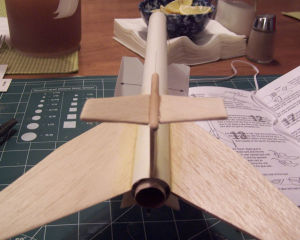
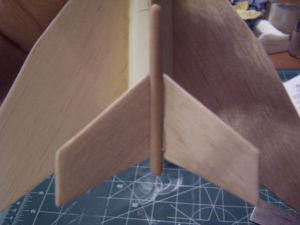 Both of my centering rings were a bit tight and would not fit around the motor tube without
some sanding of the inner surface. When the surface was sanded enough, they were slid into place and glued with yellow
glue. I then tied the Kevlar®
around the tube and aligned it with the notch. A test fit told me that it would fit. I wanted to be able to get the
Kevlar®
to the other end of the BT with a minimal amount of fuss and use it to help pull the motor mount into place.
Accordingly, I tied the other end to the eye screw provided with the kit. That let it slide to the other end just fine
and it was time to glue the motor mount in place.
Both of my centering rings were a bit tight and would not fit around the motor tube without
some sanding of the inner surface. When the surface was sanded enough, they were slid into place and glued with yellow
glue. I then tied the Kevlar®
around the tube and aligned it with the notch. A test fit told me that it would fit. I wanted to be able to get the
Kevlar®
to the other end of the BT with a minimal amount of fuss and use it to help pull the motor mount into place.
Accordingly, I tied the other end to the eye screw provided with the kit. That let it slide to the other end just fine
and it was time to glue the motor mount in place. I used a swab to apply the yellow glue inside the BT. I then dropped the eye bolt and Kevlar® through and recovered them safely on the other side. Now, with the Kevlar® aligned with the notch, it was time to feed the motor mount into the BT with gentle tension on the Kevlar® to keep everything aligned. It was a bit of a tight fit so I needed to apply a bit more tension on the Kevlar®...OOPS!
I pulled too hard and the whole thing went in too far. Way too far. My finger could not reach far enough in to grip the motor mount and I looked desperately for something to push with from the other side before the glue set up. Everything in sight seemed to be too short or too fat. In deepening desperation, I got up and looked around. My careless wife had left a wooden kitchen spoon laying in the drying rack and that seemed to be just the ticket. I put it in from the forward end, but the handle was too short. The spoon part hit the end of the BT just as the end of the handle made contact. I withdrew it knowing that I only had a few moments to spare to look around for something else. I noted absently that I would need to clean a bit of glue off the handle before the wife notices it...but dried yellow glue might be passed off as hardened scrambled eggs. What did she feed the kids that morning?
In the race against time as I balanced domestic tranquility with the precarious state of my precious rocket, the rocket won of course. Several drawers later I found a long length of 1/4" aluminum tube Gracie had thoughtfully hidden for me when I forgot to put it away and it just manage to push the motor mount back the other way. The glue was fairly stiff but I got it moved.
With great satisfaction, I returned the aluminum tube to a place of my choosing. I remembered to wipe off the yellow glue/hardened scrambled eggs from the spoon handle and sat back with a sigh.
The next step was to cut out the wrap around fin guide and transfer the lines onto the BT. That was easy enough and the lines were lengthened with the help of a door corner. Remember to align the proper line with the motor retaining hook.
The instruction would then have had me to glue on the wings to the BT but the BT was otherwise occupied allowing its glue fillets with the engine mount to dry so I skipped ahead. The wings have drop down pods that are formed by gluing a balsa oval to both side of a central balsa oval which integrate a mounting root. I decided to go ahead and assemble these so that they might be ready to glue to the wings. They went together easy enough and were of uniform size so the sanding needed to shape them was minimal. A simple layer of yellow glue was applied and then the oval was pressed into place. The process was repeated on the opposite side and then all was repeated with the other pod. I ensured that the edges were aligned, laid the assemblies flat, and set them aside to dry.
The wings were ready to be installed. According to the instructions, they should have actually gone on prior to the previous step but now I was ready. I decided to install them with CA. I figured that I had a better chance of keeping them straight if they hardened into position quickly. I used the lines I had transfered onto the BT for alignment and my eyes to ensure straightness. The result was not too shabby.
When the wings had sufficient time to stiffen up, the wing pods were installed. While they would look find to my eye hanging at a right angle, that is not the way they are intended to hang. They are intended to have a bit of an angle to them. To get the correct angle, a paper jig is provided. It is simply cut out and set against the wing and the pod root to make sure everything is at the correct angle. Again, I used CA to be sure everything set up at the correct angle while I was still attentive to such things.
The kit has two smallish fins that are to be located on the ventral surface, spaced between the launch lug and the wings. Following the instructions exactly would mean that they are installed and then have their leading, outer, and trailing edges rounded. That seemed to me to be an invitation to disaster so I sanded the contours in first.
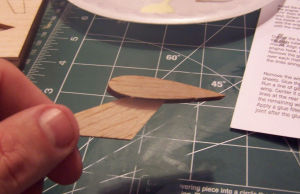

 It should be noted that the same procedure is indicated for the wings. I installed them
first and rounded them later. It makes a bit more sense in that case so that the pods can be dealt with in and
accommodated in the sanding process. So at this stage of my build, the wings remained unshaped. I will take care of
that at a later time, after the wings and pods are filleted.
It should be noted that the same procedure is indicated for the wings. I installed them
first and rounded them later. It makes a bit more sense in that case so that the pods can be dealt with in and
accommodated in the sanding process. So at this stage of my build, the wings remained unshaped. I will take care of
that at a later time, after the wings and pods are filleted.I filleted the wing/BT and Wing/pod seams with yellow glue. Then reluctantly, I put it away for the night.
When I began work again, the first task I tackled was to round the edges on the wings. This was done with a combination of sandpaper and a sanding stick. It was more difficult than I thought it would be. Some of the dried glue from the filleting process made even removal of material problematic. Also, sanding the narrow parts on the forward tips of the wings where they attach to the BT was difficult. I finally gave up on that part.
The next thing to be done was to attach the two little fins on the ventral surface. I had already rounded them and they were easily put in place with some CA.
With the fins in place, I turned my attention to the tail. It comes in 2 pieces. There is a main body and a long angular fairing. Both were glued into place with some CA. The main portion was done first and checked by eyeball for the correct angle and then the fairing was put in place. Make sure that the two pieces align correctly and are flush with one another.
The kit is supplied with a wooden dowel that goes on top of the tail assembly. The ends of the dowel need to be rounded. I used sandpaper and a sanding stick, rotating the dowel with a changing angle until it was passable. If I was still practicing structural engineering, I would call Mr. Magness and ask about the species of wood. I specialized in heavy timber construction and this stuff was hard and durable. It may have really been A36 steel with simulated wood grain. I am not a practicing engineer anymore, however, so I just disgraced myself as a man of the cloth with my strong epithets.
After the dowel was shaped, it too was put in place on top of the tail fin with a bead of CA. Make sure you get it on straight. That will be important in the next step. I was careless. The dowel went on straight but favors one side a bit more than the other. I guess it rolled to the side a fraction. I owe another act of contrition for the repeated strong language.
With the dowel more or less in place, I turned the rocket over in its cradle and filleted the fins. I let them dry overnight before tackling the other side.
The next step was to work on the horizontal stabilizers of the tail assembly. Unlike in previous steps, the instructions here say to round the leading, trailing and tip edges before installing. That was easily accomplished with a sanding stick. Putting them on was a bit more difficult.
Because I had managed to make a bit of a blunder with the installation of the rod on the vertical stabilizer, I had to make some compensations. The rod is straight, fore and aft, but is a little bit more on the starboard side than the port. The horizontal surfaces are mounted to the rod and canted a bit. I had to dry fit things several times to find out what the best compromise was.
The kit provided a cardstock alignment jig to cut out and use to get the proper angle. I am indebted to Squirrel Works for this. It made the process go easier than otherwise would have been the case. I put some CA on the root edge and eyeballed it into place on the rod. While it still had some play, I used the jig to get the angle right. When it had set up, I did the same with the other side.
The forward canards were handled in much the same way as the horizontal stabilizers but were much simpler. They were cut from the balsa, the leading, trailing, and tip edges were rounded, and they were glued into place with CA along the lines extended from the wings. Alignment was by eyeball.
While the canards were setting up, I tied the elastic shock cord off to the Kevlar® and tied the other end to the screw eye inserted into the nosecone. The screw was held in place with a dab of yellow glue.
I then judged that things had progressed far enough for me to fillet the dorsal surfaces of the canards and horizontal stabilizers. This was done with yellow glue. I put the model back into its cradle and the waiting game began again before can do any more work on it.
I began the next build session by remembering that I had completely forgotten about the launch lug. A single 1/8" lug is provided. The instructions directed me to cut it in half and glue the pieces along the line I had marked on the ventral surface. This was accomplished with the expedient of a short piece of 1/8" rod to keep the pieces aligned.
The only other thing accomplished in this build session was to fillet the undersides of the canards and horizontal stabilizers. This was done with yellow glue. Giving that a chance to set up paves the way to begin finishing.
Finishing:
Finishing began with the application of a layer of Elmer's filler. Based upon my experience and things I have read, I
suspect that I may not have been thinning it with enough water. The application I used on the Firebird was much wetter
than is usual for me.
I liked the thinner Elmer's. I devoted an evening to sanding it down as best I can and am rather pleased at the results. If I had a few more tools with which to reach the hard places, and this model has many, I think it would have been even better. As it stands now though, I am well pleased.
I sprayed on a coat of Kilz primer and let it dry. A few hours later, I sprayed on another coat. In doing so, I was able to see some sanding imperfections that escaped me before. Still, it is one of my better attempts.
After spraying in the morning and just before noon, I brought the Firebird inside for another round of sanding in the evening. I wet sanded with 320 grit sandpaper and that removed most of the blemishes that had bothered me earlier. I was satisfied enough to be ready to paint the next day.
After the primer was dry, I sprayed the entire model with Krylon gloss white. That made it look white, only more so than before. It was an improvement over the mottled primer/sealer/fingerprints but it did not really stand out. For that, I needed the yellow.
I am not a big fan of yellow but I sure like the way it looked on the facecard. Not having any on hand, I went back to Home Depot to discover that the yellow selection was limited. There were plenty of designer shades, usually pastel, going for 8 or 9 dollars a can. Besides that, there was just a single can of House Brand, bargain basement gloss yellow for $1.99 a can. Since I liked the looks of the bargain basement lid better than any of the designer ones, I went with that.
I also decided to try the Frog masking tape mentioned earlier in this thread. It is expensive but I am now a believer and will never go back. It went on easily and the edges seemed to know they were supposed to stay down. It aligned easily and had an uncanny knack for knowing when I wanted it to stick and when I didn't. The top half was masked off and a bit of aluminum foil was used to cover the tail assembly. I then gave the yellow a try.
 A few hours later I peeled off the tape was was flabbergasted. The lines were
perfect. That usually means I peeled up some of the underlying paint but that was not the case this time. From now on,
I'm using Frog tape.
A few hours later I peeled off the tape was was flabbergasted. The lines were
perfect. That usually means I peeled up some of the underlying paint but that was not the case this time. From now on,
I'm using Frog tape.
The paint results were to be considered a miracle until the real miracle occurred. She who must be obeyed, otherwise known as my loving wife, Gracie, actually said it looked good. She had never done that before.
Where this model falls down for me is in the decals. This is not Squirrel Works' fault. It is strictly my own.
Some very nice waterslides are provided and things started off well. I just had to get the tail logo on so that went on first. So far, so good. Adding the cockpit was also easy. Feeling cocky, I decided to do the hard part next.
The hard part consists of the striping along the sides. On the nosecone, this consists merely of a black line that is superimposed on the line between yellow and white. Aft of the NC, the same black line is present but there is the added complication of windows and hatches. Each side of the rocket is intended to be done with three decals.
The NC line on the port side went fine. Then tragedy struck in the form of my evil cat, Jezebel. Without going into details, first of the big window sections was destroyed.
At that point, I bewailed my fate on TRF and tried to buy another set of decals. In this I was unsuccessful. Don Magness, the proprietor of Squirrel Works was sympathetic to the depredations of satanic cats and would not sell me a replacement. Instead, he gave them to me. More than that, he sent 2 sets. Little did I know how much I would need them.
When I got back to work, I warmed up by putting on the aileron decals first. Then it was time to get down to business with the striping. I cut out the middle section of the port side and placed it in the water without thinking. When I removed the decal from the water and tried to place it, I realized my mistake. The black line has to sit right on the line between the yellow and white paint. Also sitting on that line are wings and the forward canards. I had left too much material on the decal for it to fit. I tried correcting things but wound up ruining the decal.
I was horrified. Luckily, Don Magness had a premonition of my meager skills and sent an extra set. I now only had one set left. I decided to cut the decal into several shorter and more manageable pieces, remembering to trim as close as possible to the black line.
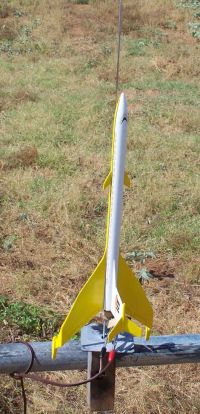 By and large, this process worked for me, especially on the starboard side
which looks pretty good. The port side looks less good, particularly over the forward canard. At this point, the decal
"gripped" before I was finished placing it. The result is a slightly curved set of windows over the canard.
By and large, this process worked for me, especially on the starboard side
which looks pretty good. The port side looks less good, particularly over the forward canard. At this point, the decal
"gripped" before I was finished placing it. The result is a slightly curved set of windows over the canard.
Let me emphasize 2 things. The problems I had were entirely due to me and an evil cat. Also, Squirrel Works rose above the call of duty in customer relations.
The end result looks good, especially when viewed from the "good side".
I decided that I wanted to do one more thing before applying the Future Floor Polish. The motor tube looked kind of sad with the top being a cloudy white and the bottom being a splotchy yellow. I decided to paint it a metallic bronze. With that done and dry, the whole thing got a couple coats of future and it was deemed ready to fly.
Construction Rating: 4 out of 5
Flight and Recovery:
The day of the maiden flight dawned hot...as in hellfire and brimstone, but nothing was going to deprive me of my
first launch window in a long while. My first rocket was the Firebird conservatively powered with an A8-3. It looked
pretty good sitting on the pad and it looked even better heading up. It got up a fair ways and the chute deployed
perfectly. Coming down was not too shabby either. In fact, I thought things had gone perfectly until I took a closer
look. I had broken off one of the horizontal stabilizers on landing.
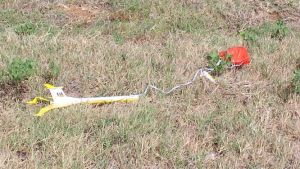 The part was found and it is an easy fix but it prevented me from launching
this one any more today.
The part was found and it is an easy fix but it prevented me from launching
this one any more today.
PROs: good flier
CONs: none
Flight Rating: 4 out of 5
Summary:
I think this is one of the best looking rockets Squirrel Works has to offer. It is a bit challenging but well within
the capabilities of anyone who has built a few already. I am looking forward to keeping this one around for a while.
Overall Rating: 4 out of 5
 |
 |
Flights
 |
 |